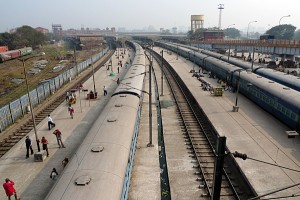Thought of Train
India’s train system is a gargantuan marvel, and if you spend any time here, you’re bound to eventually be lured into its web.
The first tracks in India were laid in 1853, with encouragement from the British East India Company. With an eye towards the flow of goods for international trade, most routes in the first 50 years were built heading to one of the three major port cities: Bombay, Madras and Calcutta.
Today, India’s railway system interconnects the entire country. 39,350 miles of tracks and counting. 6,909 railway stations. 18 million passengers per day.
That makes India the world’s 2nd largest transporter of rail passengers annually.
Pascal and I have made our own humble contribution to this impressive statistic. Given the distances between certain cities, when on a tight schedule one of the easiest ways to maximize your time is to sleep on overnight trains instead of hotels.
Of course, what sounds brilliant in theory does have a few strings in practice.
First, although Indian Railways pulls in a neat $18 billion in revenues annually (supporting 1.4 million employees–the largest commercial employer in the world), our budgets for this trip did not include splurges on expensive first-class sleeper berths. Or second class sleeper wagons, for that matter.
Instead, we opted for the more affordable 3rd class sleeper wagons (AC 3-Tier, as they’re known) whenever possible: two sets of 3 bunks facing each other (hence the 3-tier moniker) on one side of the aisle, and 2 bunks on top of each other facing lengthwise on the other side, for a total of 8 open “compartments,” or 64 bunks per wagon.
These are still a step up from the basic common “Sleeper” class wagons which make up the majority of long-distance trains (and most definitely from the regular and crowded wooden bench seat wagons.)
Here are two important things I wish I’d known.
First, never get a top bunk. All three bunk levels are cramped, but heaving yourself up to the top level and attempting to get yourself wedged into a sleeping position involves some moves and acrobatics that should only be reserved for the Kama Sutra. Let’s not even discuss getting down in the middle of the night on a moving train in the dark to find the restroom.
On the top bunk, you’re also furthest from where all the bags are stored under the bottom bunk, so most vulnerable to theft–Pascal and I often ended up sleeping with our bags, which adds a whole new layer of discomfort and contortion. Plus, in the top bunk you’re right under the main light, and nowhere near the light switch. And I mean right under, as in a very bright few inches under.
The second thing I wish I’d known: for the love of God, don’t get a bunk next to the wagon door. The bunks must be 6 feet long. That might be fine for the vast majority of Indians, but at my height of 6’1″ they were just short enough to see my sleeping feet dangle vulnerably off the edge. Right smack where the metal door opens up. There is little quite as ruinous to a good night’s sleep as a metal door repeatedly slamming into an exposed ankle or toe.
But when all is said and done, it’s quite an amazing and mostly comfortable way to travel. Now, the same can’t be said of Sleeper Class, but I’ll get to that later…

 Click to subscribe via RSS feed
Click to subscribe via RSS feed

What no mention of mice and cockroaches?? You must have gotten lucky and gotten a newer car. And don’t forget if you get the door towards the engine, you get all that sweet aroma wafting in from the bathrooms!
Ooooh, engine aroma, my favorite!
Oh yes, definitely mice and cockroaches, lol. But since those are everywhere else anyway, do they still count?
Nice story, I can definitely imagine the bunks in the wagon. But how about a photo of the bunks? and have Pascal take a photo of you squeezed in the top space with bags? I love funny photos.
The advantage of having your feet dangling off the edge is your feet wouldn’t get chewed by the mice.
Good point!